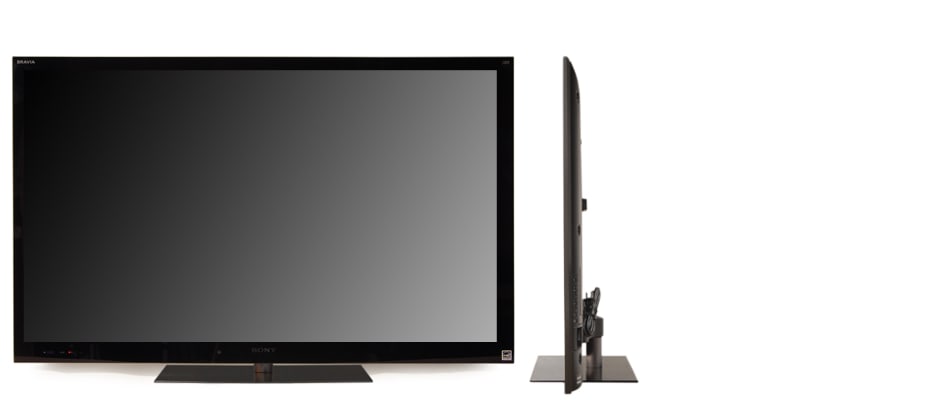Introduction
Design
{{section_header}}{{section.name}}{{/section_header}}
Sony knows how to craft a handsome TV, as proven by the HX929.
It’s hard to see from the vanity shot we have here, but there is a beautiful piece of Gorilla Glass—the front piece of many modern media devices like iPads and smartphones—that fits over the screen and the bezel. Gorilla Glass is more transparent and much stronger than typical screen coverings. When this television is turned off, it appears to have no bezel, being one solid piece of shiny black material. When the bezel is visible; about an inch of black wraps around the picture underneath the Gorilla Glass. It looks great, much like the awe inspiring Monolith from 2001: A Space Odyssey.
When it comes to connectivity, Sony has declared analog to be obsolete. There are no analog connections to get in the way of four HDMI ports, a PC connection, and two USB ports. The shedding of the analog ports makes this set of connections sleek and accessible. It is a bold move to do away with analog, but it is the next logical step. There is an adapter port that connects to both a composite and a component video input, but only one at a time. If you have older devices, you will need to throw them out immediately. According to Sony, you live in the stone age.
{{photo_gallery "Design Landing Page Photo", "Front Tour Image", "Back Tour Image", "Sides Tour Image", "Connectivity Tour Image 1", "Connectivity Tour Image 2", "Connectivity Extra Photo", "Stand Photo", "Controls Photo", "Remote Control Photo"}}
Smart TV Features
{{section_header}}{{section.name}}{{/section_header}}
The menu system is half-baked, but there is some decent streaming content to find.
Since last year, Sony has gone from winning awards for menu interface design to this unwieldy collection you see here. Our guess is that with the massive increase of online content coming to TVs, Sony hasn’t yet figured out how to present it all coherently. We imagine next year will show some improvements; hopefully by way of a simple software update, rather than buying a new set. That sounds too good to be true, though.
As far as smart TV content goes, Sony is equally lost. At first glance, online content seems to be a collection of all the premium streaming partners, like Hulu, Netflix, and Amazon Instant Video, but the Billabong Network and the NHL Vault are definitely not at the forefront of streaming popularity.
All of these options work rather well, so if the confusion of where to find them doesn’t bother you, a strongly capable smart TV awaits. The one exception to this is the internet browser. It just isn’t worth anyone’s time. It is slow and relies on the use of the arrow buttons on the remote to type in URLs or select any link on a page. You probably have a smart phone or an iPad handy if you are trying to buy a $2,500 television, so use those to get on the internet instead.
{{photo_gallery "Software and Internet Landing Page Photo", "Internet Features 1 Photo", "Internet Features 2 Photo", "Internet Features 3 Photo", "Browser 1 Photo", "Browser 2 Photo", "Browser 3 Photo", "Apps 1 Photo", "Apps 2 Photo", "Apps 3 Photo", "Local Media Playback 1 Photo", "Local Media Playback 2 Photo", "Menu Main Photo", "Menu 2 Photo"}}
Picture Quality
{{section_header}}{{section.name}}{{/section_header}}
The Sony Bravia HX929 displays an above-average picture… but horrible screen uniformity.
The Sony Bravia HX929 was adept at showing accurate colors. Black and white detail was excellent: The HX929 was able to produce a decent black level and brilliant peak white level. Unfortunately, the peak brightness was so bright that it caused the screen uniformity to suffer.
When the screen goes dark, and not just between commercials, but in a dark movie like a Batman flick, you will see four huge halos emanating from the four corners of the screen. This is a defect called flashlighting, caused by the LED backlighting shining right through the display, completely detracting from what should be an intimate or quiet scene. Its extremely pronounced on the XBR-46HX929—we have never seen anything like this.
At least this Sony display has an impressive starting refresh rate of 240 Hz. Additionally, there are two motion processing modes on the HX929: CineMotion and Motionflow. With these combined, Sony claims refresh rates up to 960 Hz, which is a bit deceptive. The baseline refresh rate of 240 Hz is strong, and with these extra features interpolating frames between frames, the refresh rate is artificially enhanced. We turned both of these modes on to test motion and we saw a strong performance.
3D
{{section_header}}{{section.name}}{{/section_header}}
Sony delivers a very good 3D performance with the HX929.
We tend to notice that 3D images these days are either unwatchable or substandard. Some images suffer from crosstalk. Other times, the difference between the plane of the television and where we are supposed to focus our eyes contradicts enough to cause severe eyestrain. The alternative is that the 3D depth is reduced, free of physical pain and brain confusion, but just not that 3D.
With our subjective judgment, developed from having experienced all the 3D systems across the television market, we would like to say that the 3D on the Sony Bravia HX929 was impressive. The X929 uses active shutter 3D glasses to display full HD 3D images. These images fell in the less depth category, and we think this is the best option of the two. Crosstalk was noticeably absent from most images and we did not experience the discomfort that we expect to endure when testing 3D. The lack of depth was disappointing, but objects were certainly arranged in front and behind one another in space.
Conclusion
{{section_header}}{{section.name}}{{/section_header}}
A great overall TV is hampered by screen uniformity issues.
The Sony Bravia XBR-46HX929 (MSRP $2,499) had a lot going for it. The contrast ratio was grand, stemming from one of the highest peak brightnesses we have seen on a TV. The color accuracy was near exact, matching up reasonably with any other top model from this year. The motion processing was also strong, using two different processing modes to achieve refresh rates of 960Hz, according to Sony. The 3D didn’t make us immediately sick and the online offerings were vast.
Here is the part where we undercut all of the benefits, phrased as a message to Sony: If you are trying to make a great television, you should ensure that the simplest aspects are taken care of first. Then, you can put in the high end performance that will make it top-of-the-line. If you have a great contrast ratio and spectacular colors, it doesn’t matter much if there are giant cloudy halos shining through all of the corners of the screen. Seriously, the flashlighting was egregious and inexcusable. Consumers will be upset about spending this much on a TV, only to come home to see large and obvious cloudy patches taking up much of the picture. Furthermore, if you want to provide all of the most advanced processing and online features, start with an intuitive menu system. Plenty of content that is hard to access is the same as a great picture you can’t see.
We can see serious gamers enjoying this television for its motion, color, brightness, and contrast performances. But if these gamers ever wanted to watch a movie that utilizes heavy shadows, they will bemoan the day they spent a small fortune on this Sony.
Science Introduction
{{section_header}}{{section.name}}{{/section_header}}
The Sony Bravia HX929 excelled in many areas, including color accuracy, contrast, and motion performance. The biggest flaw with this set was its awful screen uniformity, which showed plenty of flashlighting.
Screen Uniformity
{{section_header}}{{section.name}}{{/section_header}}
Flashlighting at its worst.
We mentioned that the screen uniformity suffered from terrible flashlighting, which is when halos of light are noticeable on a black screen. We are not exaggerating when we say this is extremely noticeable and distracting. Usually, a television will receive a bad uniformity score if some of the backlights are visible on an all-black screen, though when watching content it does not take away from the viewing experience. This was clearly evident in any scene that was not overly lit, which really describes most parts of many movies.
You can see a shot we took of the screen with an input signal of pure black. Compare the brightness of the Sony logo to the foggy halos in the corners and you get an idea of how obvious they are.
On the other hand, the backlights are so powerful that you will never see the lighting on a bright screen. Any gaming situation or sitcom will be fine. You can take a few points off the maximum backlight setting in an attempt to contain the backlighting, but we noticed that even bringing it down from 10 to 2 (our lowest recommended setting) did not improve much.
{{photo_gallery "Science Section 1 Images"}}
Color
{{section_header}}{{section.name}}{{/section_header}}
The HX929 produces accurate colors.
Matching the international standard for colors on HDTVs is difficult and requires expensive hardware. In the chart, the international standard is the black triangle representing the standard. The white triangle shows how the HX929 matched this standard. The biggest error is in the blue values, which are slightly undersaturated. All together, these colors are a strong match.
Compiling all of the color information, we have a well matched set of colors that transition smoothly along the luminance spectrum and show no tinting due to color temperature. These three marks of quality add up to a great color performance.
{{photo_gallery "Science Section 2 Images"}}
Contrast
{{section_header}}{{section.name}}{{/section_header}}
The contrast is very good, but the local dimming deserves an explanation.
With such a high peak brightness, the HX929 has a great range of blacks and whites which translates into a fantastic contrast ratio. Each one of the models in the chart is a performer and this Sony competes with some of the best in contrast ratio.
One of the few unique features of the HX929 series is full-array local dimming, where the screen is broken up into 105 zones that adjust the backlight according to what is on the screen. If there is a bright fireball flying across a deep blue sky, the zones will brighten when the fireball passes, and dim when there is just sky to display. We turn these functions off to test contrast because they affect the peak brightness and the black level artificially. Only using 105 zones is not enough detail to accurately dim or brighten images that use over 2,000,000 pixels in the 1080p format. Generally, you will notice that an area around bright moving objects will also be brightened.
{{photo_gallery "Science Section 3 Images"}}
Other Tests
{{section_header}}{{section.name}}{{/section_header}}
{{photo_gallery "Other Tests Images"}}
Meet the tester
An enthusiast of all things tech, Josh is one of Reviewed.com's resident television experts. When he's not looking at bright TV screens in a dark room, he's probably reviewing a laptop or finding a new snack at 7-11.
Checking our work.
Our team is here for one purpose: to help you buy the best stuff and love what you own. Our writers, editors, and lab technicians obsess over the products we cover to make sure you're confident and satisfied. Have a different opinion about something we recommend? Email us and we'll compare notes.
Shoot us an email


